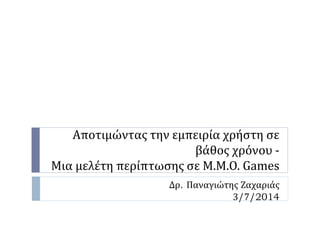Panagiotis zaharias assessing long term ux of mmo gs
- 1. ╬æŽĆ╬┐Žä╬╣╬╝ŽÄ╬ĮŽä╬▒Žā Žä╬Ę╬Į ╬Ą╬╝ŽĆ╬Ą╬╣Žü╬»╬▒ ŽćŽü╬«ŽéŽä╬Ę Žé╬Ą ╬▓╬¼╬Ė╬┐Žā ŽćŽüŽī╬Į╬┐Žģ - ╬£╬╣╬▒ ╬╝╬Ą╬╗╬ŁŽä╬Ę ŽĆ╬ĄŽü╬»ŽĆŽäŽēŽé╬ĘŽā Žé╬Ą M.M.O. Games ╬öŽü. ╬Ā╬▒╬Į╬▒╬│╬╣ŽÄŽä╬ĘŽā ╬¢╬▒Žć╬▒Žü╬╣╬¼Žā 3/7/2014
- 2. Time spans of UX Source: http://www.allaboutux.org/files/UX-WhitePaper.pdf
- 3. UX in the long term: an important but neglected issue (1) ’üĮ While the importance of temporality has been repeatedly highlighted in user experience research, it has rarely been systematically addressed. ’üĮ ŌĆ”Due to the effort involved in conducting longitudinal studies. ’üĮ or a lack of sufficient interest, induced by a belief that motivating prolonged use does not necessarily lead to increased commercial revenues.
- 4. UX in the long term: an important but neglected issue (2) ’üĮ 2 Main Trends that highlight the importance of long term UX (Karapanos et al. 2010): ’üĮ Products are becoming service-centered. ’üĮ products sold for lower prices, and thus revenues are mainly coming from the supported service. ’üĮ prolonged use therefore has a direct impact on the revenues of a company. ’üĮ Time and coverage of product warranty increases due to legislation and competition enforcement. ’üĮ An increasing number of users tend to complain about the experiential aspects of products that go beyond the out-of-the-box experience
- 5. Assessing long-term UX in the context of MMOGs
- 6. Context of the study ’üĮ Based on: ’üĮ Moschou, E. and Zaharias, P. UX-Curve revisited;Assessing long-term user experience of MMOGs. In CHI 2013Workshop on Games User Research, (2013). ’üĮ Why long term UX in MMOGs? ’üĮ Shortage of relevant studies so far ’üĮ Players usually have a long lasting relationship with the game they play ’üĮ The main objective of the study: ’üĮ To investigate, understand and interpret the changes of playersŌĆÖ experience over time
- 7. The method: A new version of UX Curve ’üĮ UX Curve: A retrospective method for assessing long term UX proposed by Kujala et al. (2011). Based on drawings made by users Cost efficient as a long term usage can be covered in a single session Results give an overview of the most relevant experiences Memories are as important or more than actual experiences
- 9. Towards a new version of UX Curve ’üĮ The game: League of Legends ’üĮ The players: 9 students aged between 18-20 years old who had been playing LoL for periods ranging from 6 to 16 months (mean: 12.5 months SD: 3.1 months) ’üĮ The new version of UX Curve: UX Curve ŌĆó General UX ŌĆó Attractiveness ŌĆó Ease of use ŌĆó Utility ŌĆó UsageVolume UX Curve (MMOG version) ŌĆó General UX ŌĆó Degree of usage ŌĆó Ease of use ŌĆó Immersion ŌĆó Social interaction ŌĆó Engagement
- 10. Indicative results (1) ’üĮ A total of 54 curves were collected. Most of the curves were improved revealing thus an increasing user experience General UX Curve for each user ID The immersion UX Curve for each user ID
- 11. Indicative results (2) ’üĮ In order to draw the curves, players described the factors that improved their experience over time or caused it to deteriorate Reason Categories Positive Negative Usability 6 4 Utility 3 2 Aesthetics 7 0 Gameplay 5 3 Challenge 6 0 Social interaction 7 5 Interest 6 0 Miscellaneous 3 0 Sum 43 14 Table2 -The categories of the reasons for general UX curve Reason Categories Positive Negative General UX 43 14 Ease of use 41 26 Immersion 43 10 Social interaction 38 12 Engagement 32 10 Total 197 72 Table 1- Number of reasons for general and specific UX dimensions
- 12. Indicative results (3) ’üĮ All except for two ŌĆ£Ease of useŌĆØ curves were improving or stable, with pragmatic-related reasons to be the most frequent. ’üĮ most negative perceptions related to usability and utilities reasons ’üĮ Overall, most of the issues influencing the long-term user experience in the game were related to non-pragmatic issues such as fun, immersion, challenge, interest and control.
- 13. Key Takeaways ’üĮ It is crucial to measure UX in the long term ’üĮ Retrospective methods can greatly help in understanding how UX changes over time ’üĮ Memories are as or more important than actual experiences ’üĮ UX Curve is a cost efficient and effective method to use for analyzing and understanding long term UX ’üĮ The new proposed version of UX Curve (adjusted for gaming environments) seems to be a valid and effective method for assessing long term UX of MMOG players ’üĮ It can be applied to many other contexts for evaluating products/services/systems
- 14. Thank you! ’üĮ Email: pz@aueb.gr ’üĮ Web: about.me/panagiotis_zaharias














